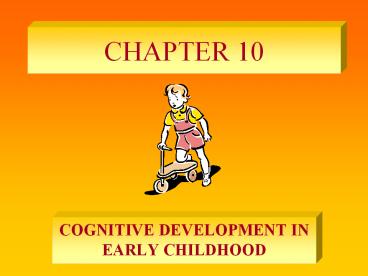COGNITIVE DEVELOPMENT IN EARLY CHILDHOOD - PowerPoint PPT Presentation
Title:
COGNITIVE DEVELOPMENT IN EARLY CHILDHOOD
Description:
... the child gains the ability to represent an object mentally that is not present. ... skills are mediated by words and language, which facilitate mental activity. ... – PowerPoint PPT presentation
Number of Views:96
Avg rating:3.0/5.0
Title: COGNITIVE DEVELOPMENT IN EARLY CHILDHOOD
1
CHAPTER 10
- COGNITIVE DEVELOPMENT IN EARLY CHILDHOOD
2
COGNITIVE DEVELOPMENTAL CHANGESPiagets
Preoperational Stage approximately two to seven
years of age operations are internalized sets
of actions that are highly organized and conform
to certain rules and principles of logic.
3
- Symbolic Function Sub-stage two to four years
of age where the child gains the ability to
represent an object mentally that is not present. - Egocentrism feature of preoperational though
where child is unable to distinguish between
ones own perspective and that of others. - Animism second feature of preoperational
thought where child has belief that inanimate
objects have lifelike qualities.
4
- Intuitive Thought Sub-stage four to seven years
of age where children begin to use primitive
reasoning and have many questions this stage is
characterized by a childs assuredness that she
is correct in her thinking. - Centration a focusing of attention on one
characteristic to the exclusion of all others. - Conservation the preoperational child has a
lack of conservation in that he feels an amount
becomes larger or smaller when it is manipulated.
5
Vygotskys Theory of Development described in
three basic principles
- Childs cognitive skills are understood only when
developmentally analyzed. - Cognitive skills are mediated by words and
language, which facilitate mental activity. - Cognitive skills originate in sociocultural
background of the child.
6
- Zone of proximal development (ZPD) range of
tasks beyond the mastery of the child but that
are learned with guidance. - Scaffolding consistently adjusting the amount
of guidance to match the students performance
level. - Language and thought Language issued for
self-regulation and is called inner speech, is
considered an important tool of thought in each
childhood. - Teaching strategies based on Vygotskys theory
Child is challenged through use of ZPD and
scaffolding to bring her to higher levels of
performance. Learning should be with skilled
peers and teachers who monitor the childs use of
private speech and assess her ZPD, not her IQ. - Evaluation and comparing Vygotskys and Piagets
theories Piaget considers inner speech to
reflect immaturity, not a tool in development.
Vygotsky is a social constructivist while Piaget
rejects the impact of social influence and
believes children construct knowledge through
transforming and organizing prior knowledge.
7
Information Processing Memory plays a key role
in cognitive development.
- Attention In early childhood, a moving away fro
habituation and dishabituation toward selective
attention focusing on a specific aspect of
experience while ignoring others. - Control of attention Preschool children begin
to focus their attention specifically (on
television, for example) versus toddlers who
wander their attention. - Salient versus relevant dimensions From
preschool year to age six to seven there is a
gradual shift toward attending to relevant
aspects versus those that stand out and are
flashy when solving a problem. - Planfulness A focus on detain when making
comparisons is found as children grow older. - Adjusting attention A childs ability to change
the rate of attention when confronting easy to
difficult material (i.e., reading). - Knowledge of attention Preschool versus older
children do not seem to have control over how to
focus on a subject in order to remember it.
8
EXPECTANT PARENTS
- Confirming the pregnancy Fetal life begins with
the fertilization of the ovum, with pregnancy
length calculated from the first day of the
womans last menstrual period.
The Three Trimesters First initial three
months when prenatal organ systems are formed
physical and emotional adjustment for the mother
Second middle months, continued growth of
fetus, mothers physical adjustment to the
change Third uterus expands, some leg problems
with blood flow, physically exhausting.
9
The Expectant mothers nutrition, weight gain,
and exercise are monitored for her health and
that of her baby. Weight gain should be between
2.2 pounds per month and 6.6 (excessive).
Appropriate levels of vitamins and adequate
exercise all contribute to a healthy balance.
- Culture and Prenatal care are also considerations
that affect the fetus. Industrial countries
generally have lower numbers of low-birthweight
babies, with the United States at 7 percent
however, this is higher among African-American
infants.
Cultural beliefs also impact prenatal care In
India midwives play a large role in the birthing
process. Other cultures rely on ancient
medicinal practices and/or strong familial
cooperation.































